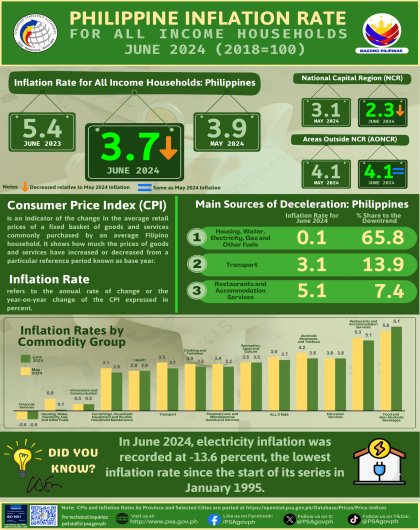Summary Inflation Report Consumer Price Index (2018=100): June 2024
The Philippine Statistics Authority (PSA) is ready to release the Consumer Price Index (CPI) for All Income Households with base year 2012 on 06 March 2018. The 2012-based CPI is the tenth in the rebasing series.
The CPI is an indicator of the change in the average prices of a fixed basket of goods and services commonly purchased by an average Filipino household for their day-to-day consumption relative to a base year. The base year for the current CPI series is 2006.
As an indicator, the CPI is most widely used in the calculation of the inflation rate and purchasing power of the peso (PPP). Inflation rate measures the changes in the CPI over a specific period of time (usually a month or a year). The PPP, on the other hand, gives an indication of how much the Philippine peso is worth in a given period relative to its value in a base period.
The CPI also serves as basis for economic analysis, for collective bargaining agreements, for wage adjustments, and for monitoring the effects of government economic policy on households.
Historical Brief
The CPI was formerly referred as the Cost of Living Index (CLI). The estimation of the CLI was undertaken by the Labor Statistics Division of the Department of Labor. The task of calculating the said index was transferred to the then Bureau of the Census and Statistics (BCS) (reconstituted as the National Statistics Office) on 01 January 1941.
The first series constructed by the BCS was in 1945. The CLIz series had 1941 as base year and covered only Manila. The market basket contained 66 commodities representing goods and services commonly purchased by low-income families (families living within minimum level of subsistence). This series lasted for 18 years (1945 to 1963).
In 1964, weights were based on the results of the 1961 Survey of Income and Expenditures and the average price for 1960-1962 was used as the base price. This series was referred to as the Consumer Price Index for Low-Income Families in Manila (families whose annual income did not exceed P2,400). The market basket was almost four times larger as it contained 244 items.
Since the first revision, the CPI has undergone several updating and rebasing exercises.
Previous CPI series had 1941, 1961, 1966, 1972, 1978, 1988, 1994 and 2000 as base years. The results of the last CPI rebasing exercise, shifting the base year from 2000 to 2006 came out in July 2011.
Rationale for Rebasing the CPI from 2006 to 2012
Rebasing is necessary when the basket of the reference year no longer represents what is commonly purchased by the households. The CPI then becomes irrelevant and would tend to give wrong market signals. The CPI is an indicator that derives its usefulness from its representation of how much a typical market basket behaves over a specific period of time.
Economic, social and technological changes may have influenced Filipinos’ tastes and preferences and these, in effect may have resulted in changes in the consumption patterns of the population. As household expenditure patterns vary (they tend to spend less on some items and more on others), weights are used to ensure that the CPI reflects the relative importance of each item or group of items in the market basket. The weights are expressed as a proportion of household expenditure for an item to the total national expenditure.
The rebasing of the CPI from 2006 to 2012 is in consonance with the recommendation of the PSA Board in its Resolution No. 01 series of 2017-146 (Approving the Synchronized Rebasing of Price Indices to Base Year 2006 and every six (6) years thereafter) to reflect the latest composition of goods and services consumed and availed of by households across provinces of the country.
The main data source of consumption pattern (CPI weights) for this latest rebasing was the 2012 Family Income and Expenditure Survey (FIES). Meanwhile, the Survey of Key Informants was conducted from 07 October to 15 November 2013 to determine the commodities that will form the market basket for the 2012-based CPI.
The Survey of Key Informants was conducted nationwide to store managers, sellers or proprietors and were asked of the most commonly purchased items or commodities. The commodities are grouped according to the 2010 Philippine Classification of Individual Consumption According to Purpose (PCOICOP) which is based on the United Nations COICOP.
Methodological changes were also introduced in the 2012-based CPI. In the new series, the “chain” method is used as it will provide timely indicators since this method allows the inclusion of new commodities in the market basket that are frequently purchased because of the changing consumer taste and preferences and technological changes. The new (chain) method also allows the exclusion of commodities as a result of obsolescence.
Adoption of the 2012-based CPI series and the chain method in CPI computation was approved by the PSA Board during its board meeting on 13 February 2018. The PSA will release the rebased CPI series on 06 March 2018 and this will include monthly CPI from January 2012 to February 2018. Data users will expect two sets of the CPI as the new series shall be issued simultaneous with the 2006-based series until June 2018. CPI series for July 2018 onwards shall be 2012-based.
Together with this announcement are the details on rebasing the CPI.
(Sgd) LISA GRACE S. BERSALES, Ph.D.
Undersecretary
National Statistician and Civil Registrar General


